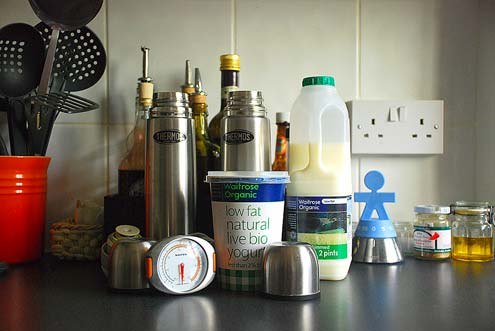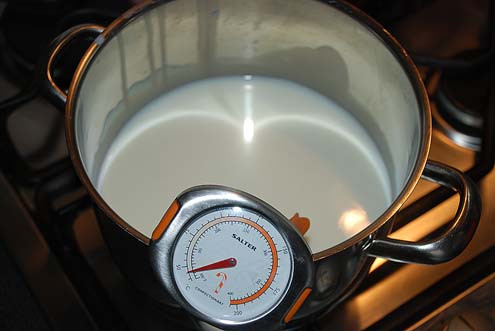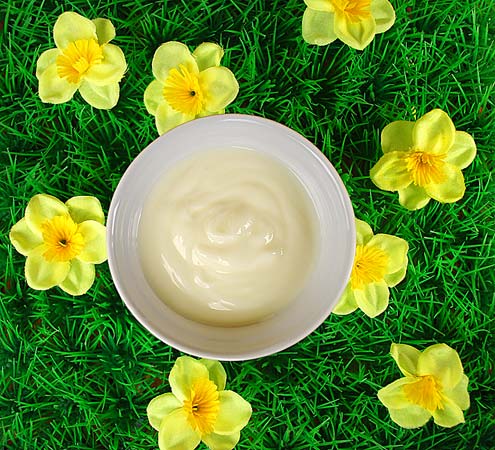The making of yoghurt has been the most exciting discovery in the yumblog kitchen since the finding of a forgotten and unopened Kellogg’s Variety Pack at the back of the cupboard. There are a multitude of techniques for transforming milk into yoghurt, but our objective was always to do it with the least amount of faff, equipment and financial investment. The knack/problem is to keep the milk at a constant 50C for 8 hours and it is something we are still working on … as the title suggests. That said, so far both attempts have produced delicious, thick, creamy yoghurt.

Preparation time: 15 minutes plus 8-12 hours
Cooking time: 5 – 10 minutes
Skill level: easy
Ingredients
- milk – full fat, semi or skimmed – 1 litre
- natural live yoghurt – 1 dessert spoon
Extra equipment needed
- Thermos flask – 1 litre capacity
- sugar thermometer
- sterile jar – 1 litre capacity
- anything else you can think of that will keep the contents of the flask at a constant temperature

Fill your Thermos with boiling water, screw on the lid and set aside. This will sterilise the flask as well as bring it up to temperature.
Pour the milk into a saucepan and gently heat to 82C, stirring continually as it gets up to temperature to avoid it catching at the bottom. Heating the milk to this temperature will kill all the ‘bad’ bacteria as well as alter its structure in some scientific way or other.
Once 82C is reached, turn off the heat and allow to cool to 50C – stir occasionally to ensure the milk is at a uniform temperature throughout. 50C is the optimum temperature for the ‘good’ yoghurt-forming bacteria.
At 50C stir in a desert spoon of live yoghurt.

Pour the boiling water out of the Thermos and replace with the milk/yoghurt mixture. Seal and set aside for 8-12 hours. Resist the temptation to fiddle and possibly go to Greenwich for a nice day out.

Now this is where you can get creative and devise all sorts of Heath Robinson contraptions to keep your yoghurt snug and warm. The first time I simply left the flasks sitting in a corner of the kitchen and the second I put them in a cooler bag and padded it out with towels. Both times I got something which although obviously yoghurt was disappointingly runny.
But despair not because all you need to do is pour it into a sieve lined with a (clean) tea-towel and place this over a bowl for a few hours to drain. One hour will give you a thickish yoghurt, up to three will result in a delicious creamy Greek style yoghurt. Anything longer than that and we’re probably heading into cheese territory.
Whatever technique you opt for, finish by placing in a sterilised jar and storing in the fridge. Remember to keep enough to start off your next batch and you’ll never have to buy yoghurt again.
Verdict: Rich, thick, creamy and mild.
Drink: A variety of Meantime ales in the garden at the excellent Greenwich Union.
Entertainment: A walk around Greenwich Park followed by an early dinner at the above. A well-hung chunk of steak for her, a moist piece of cod for him. Both very tasty.



I use a heated propagator for my yoghurt and mix in a little skimmed milk powder along with the milk and yoghurt for a thicker yoghurt.
If you strain it in a cheesecloth it goes even thicker.
If you mix in a pinch of salt, tsp garlic powder and some mixed herbs and leave this to strain in a cheesecloth overnight you end up with a cheap and tasty version of Rouille Cheese! Great on hot toast!
Hi Stripy Socks
Thanks for the yoghurt advise … I’ll definitely give the cheese a go this weekend.
Do you do anything with your leftover whey?
Best
R